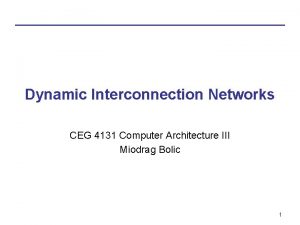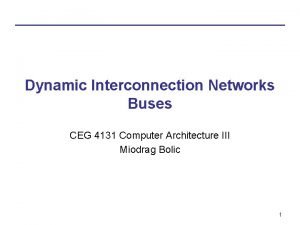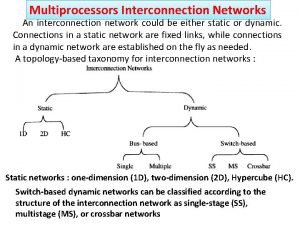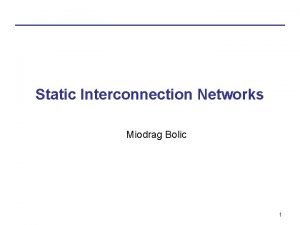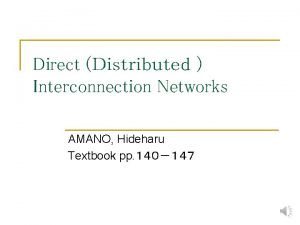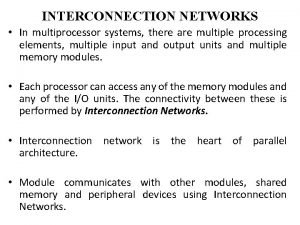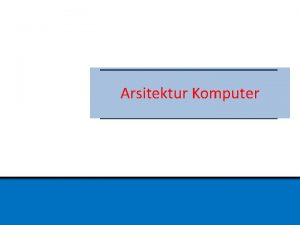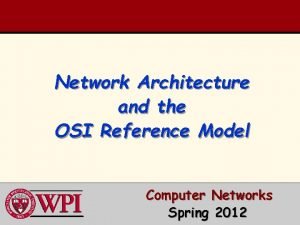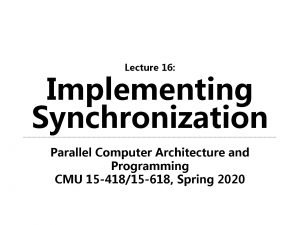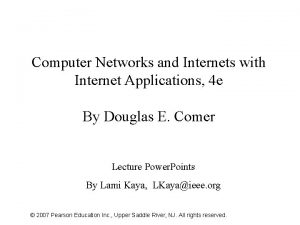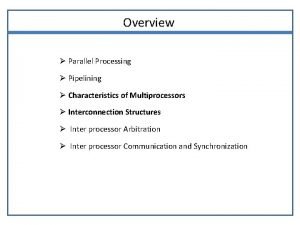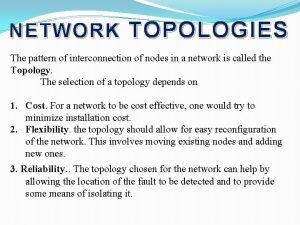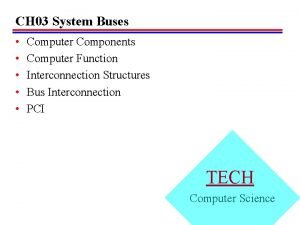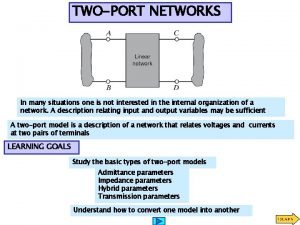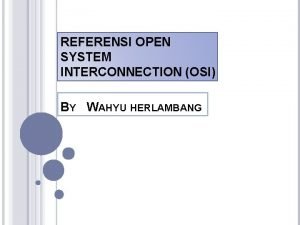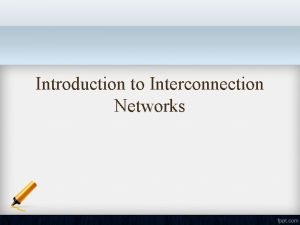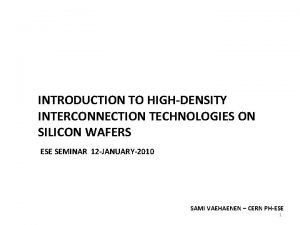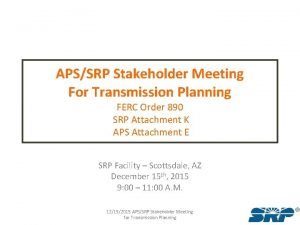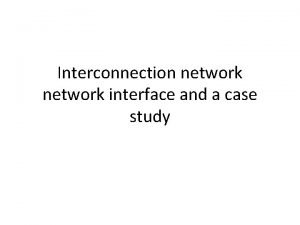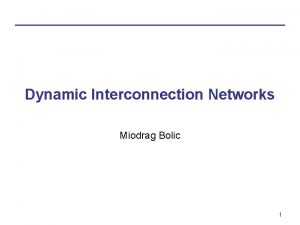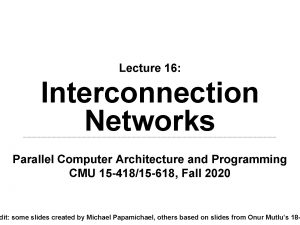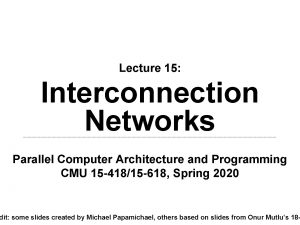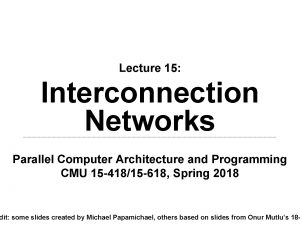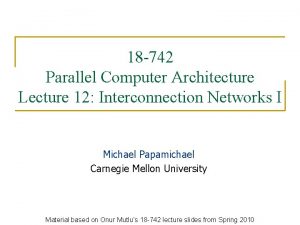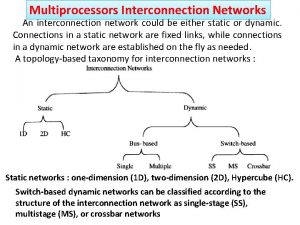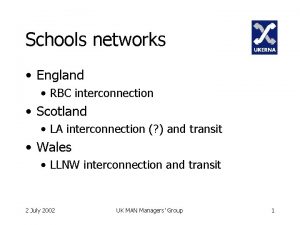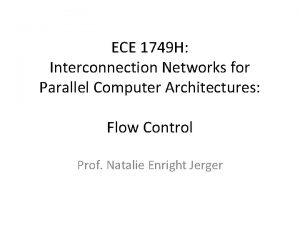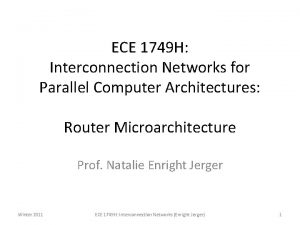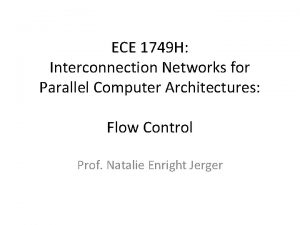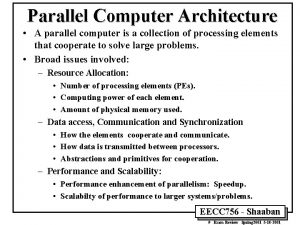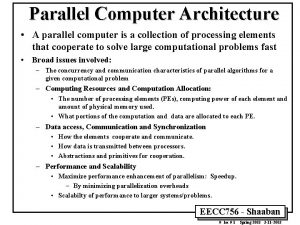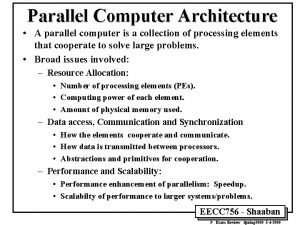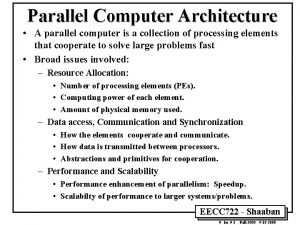Lecture 15 Interconnection Networks Parallel Computer Architecture and



















































- Slides: 51

Lecture 15: Interconnection Networks Parallel Computer Architecture and Programming CMU 15 -418/15 -618, Spring 2018 dit: some slides created by Michael Papamichael, others based on slides from Onur Mutlu’s 18 -

Basic system design from previous lectures. Process or or Cache Interconnect (shared bus) Bus clients (interconnect nodes) Bus interconnect: All nodes connected by a shared set of wires Bus Arbitrator Memory e. g. , 40 bits e. g. , 256 bits 3 bits Request bus: cmd + address Response bus: data Response tag CMU 15 -418/618, Spring 2018

Today: modern interconnect designs. Process or or Cache Interconnection Network Interconnect nodes Memory Today’s topics: the basic ideas of building a high-performance interconnection network in a parallel processor. (think: “a network-on-a-chip”) CMU 15 -418/618, Spring 2018

What are interconnection networks ▪ To connect: used for? - Processor cores with other cores Processors and memories Processor cores and caches Caches and caches I/O devices CMU 15 -418/618, Spring 2018

Why is the design of the interconnection network important? ▪ System scalability - How large of a system can be built? How easy is it to add more nodes (e. g. , cores) ▪ System performance and energy efficiency - How fast can cores, caches, memory communicate How long is latency to memory? How much energy is spent on communication? CMU 15 -418/618, Spring 2018

With increasing core counts… Scalability of on-chip interconnection network becomes increasingly important Intel core i 7 (4 -CPU cores, + GPU) Intel Xeon Phi (72 -core x 86) Tilera GX 64 -core chip Tegra K 1: 4 + 1 ARM cores + CMU 15 -418/618, GPU cores Spring 2018

Interconnect terminology CMU 15 -418/618, Spring 2018

Terminology ▪ Network node: a network endpoint connected to a router/switch - Examples: processor caches, the memory controller - Connects nodes to the network - Connects a fixed number of input links to a fixed number Network interface of output links ▪ Network interface: ▪ Switch/router: ▪ Link: - No de A bundle of wires carrying a signal 0 1 Swit ch Lin k 2 3 CMU 15 -418/618, Spring 2018

Design issues ▪ Topology: how switches are connected via links - Affects routing, throughput, latency, complexity/cost of implementation ▪ Routing: how a message gets from its source to its destination in the network - Can be static (messages take a predetermined path) or adaptive based on load ▪ Buffering and flow control - What data are stored in the network? packets, partial packets? etc. - How does the network manage buffer space? CMU 15 -418/618, Spring 2018

Properties of interconnect topology ▪ Routing distance - Number of links (“hops”) along a route between two nodes ▪ Diameter: the maximum routing distance ▪ Average distance: average routing distance over all valid routes Example: diameter = 6 CMU 15 -418/618, Spring 2018

Properties of interconnect topology ▪ Direct vs. indirect networks - Direct network: endpoints sit “inside” the network e. g. , mesh is direct network: every node is both an endpoint and a switch Direct network Indirect network CMU 15 -418/618, Spring 2018

Properties of an interconnect topology ▪ Bisection bandwidth: - Common metric of performance for recursive topologies - Warning: can be misleading as it does not account for switch and routing efficiencies Cut network in half, sum bandwidth of all severed links ▪ Blocking vs. non-blocking: - If connecting any pairing of nodes is possible, network is non-blocking (otherwise, it’s blocking) CMU 15 -418/618, Spring 2018

Example: blocking vs. non▪blocking Is this network blocking or non-blocking? - Consider simultaneous messages from 0 -to-1 and 3 -to-7. 0 0 1 1 2 2 3 3 4 4 5 5 6 6 7 7 Note: in this network illustration, each node is drawn twice for clarity (at left CMU 15 -418/618, Spring 2018

Example: blocking vs. non▪blocking Is this network blocking or non-blocking? - Consider simultaneous messages from 0 -to-1 and - 3 -to-7. Consider simultaneous messages from 1 -to-6 and 0 0 3 -to-7. Blocking!!! 1 1 2 2 3 3 4 4 5 5 6 6 7 7 Note: in this network illustration, each node is drawn twice for clarity (at left Conflict CMU 15 -418/618, Spring 2018

Load-latency behavior of General rule: latency increases with load network (throughput) Zero load or idle latency Throughpu t given by routing Latency (topology+routi ng+flow control) Throughput given by topology Min latency given by routing algorithm Min latency given by topology Saturation throughput (given by flow control) Load - Offered Traffic (bits/sec) CMU 15 -418/618, Spring 2018

Interconnect topologies CMU 15 -418/618, Spring 2018

Many possible network topologies Bus Crossbar Ring Tree Omega Hypercube Mesh Torus Butterfly … CMU 15 -418/618, Spring 2018

Bus interconnect ▪ Good: - Simple design Cost effective for a small number of nodes Easy to implement coherence (via snooping) ▪ Bad: - Contention: all nodes contend for shared bus Limited bandwidth: all nodes communicate over same wires (one communication at a time) - High electrical load = low frequency, high power 0 1 2 3 4 CMU 15 -418/618, Spring 2018

Crossbar interconnect ▪ Every node is connected to ▪ ▪ every other node (nonblocking, indirect) Good: - O(1) latency and high bandwidth Bad: - Not scalable: O(N 2) switches High cost Difficult to arbitrate at scale Crossbar scheduling algorithms / efficient hardware implementations are still active research areas. 0 1 2 3 4 5 6 7 8 -node crossbar network (N=8) Note: in this network illustration, each node is drawn twice for CMU 15 -418/618, Spring 2018

Crossbar interconnect (Here is a more verbose illustration that on previous slide) 0 1 2 3 4 5 6 7 CMU 15 -418/618, Spring 2018

Crossbars were used in recent multi-core processing from Oracle (previously Sun) Sun SPARC T 2 (8 cores, 8 L 2 cache banks) Oracle SPARC T 5 (16 cores, 8 L 3 cache banks) Note that crossbar (CCX) occupies about the same chip area as a core CMU 15 -418/618, Spring 2018

Ring ▪ Good: ▪ - Simple Cheap: O(N) cost Bad: - High latency: O(N) - Bisection bandwidth remains constant as nodes are added (scalability issue) ▪ Used in recent Intel architectures - Core i 7 0 1 2 3 ▪ Also used in IBM CELL Broadband Engine (9 cores) CMU 15 -418/618, Spring 2018

Intel’s ring interconnect Introduced in Sandy Bridge microarchitecture System ▪ Four rings - Agent L 3 cache slice (2 MB) Core ▪ Six interconnect L 3 cache slice (2 MB) Core L 3 cache slice (2 MB) request snoop Ack data (32 bytes) Core Graphics nodes: four “slices” of L 3 cache + system agent + graphics ▪ Each bank of L 3 ▪ connected to ring bus twice Theoretical peak BW from cores to L 3 at 3. 4 GHz is approx. CMU 15 -418/618, 435 GB/sec Spring 2018

Mesh ▪ Direct network ▪ Echoes locality in grid-based applications ▪ O(N) cost ▪ Average latency: O(sqrt(N)) ▪ Easy to lay out on chip: fixedlength links ▪ Path diversity: many ways for ▪ message to travel from one node to another Used by: - Tilera processors - Prototype Intel chips 2 D Mesh CMU 15 -418/618, Spring 2018

Xeon Phi (Knights Landing) ▪ 72 cores, arranged as 6 ▪ x 6 mesh of tiles (2 cores/tile) YX routing of messages: - Move in Y - “Turn” - Move in X CMU 15 -418/618, Spring 2018

Torus ▪ Characteristics of mesh topology are different based on whether node is near edge or middle of network (torus topology introduces new links to avoid this problem) ▪ Still O(N) cost, but higher cost than 2 D grid ▪ Higher path diversity and bisection BW than mesh ▪ Higher complexity - Difficult to layout on chip Unequal link lengths 2 D Torus CMU 15 -418/618, Spring 2018

Folded Torus ▪ Interleaving rows & columns eliminates need for long connections ▪ All connections doubled in length Torus 00 10 20 30 Folded Torus 00 10 30 01 11 21 31 02 12 22 32 20 01 11 31 21 03 13 23 33 12 02 32 22 CMU 15 -418/618, Spring 2018

Trees ▪ ▪ Planar, hierarchical topology Like mesh/torus, good when traffic has locality Latency: O(lg N) Use “fat trees” to alleviate root bandwidth problem (higher bandwidth links near root) 0 2 8 10 1 3 9 11 4 6 12 14 5 7 13 15 H-Tree 0 1 2 3 4 Fat Tree 5 6 7 CMU 15 -418/618, Spring 2018

Tree Routing ▪ Getting from 1 to 2: Upward: • Until have common anc Downward: • 0 left, 1 right ▪ 1 = 0012 2 = 0102 Getting from 3 to 6: - 3 = 0112 - 6 = 1102 0 1 2 3 4 5 6 7 CMU 15 -418/618, Spring 2018

Fat Tree ▪ Charles Leiserson, ▪ ▪ ▪ 1985 Increase bandwidth between nodes as move upward O(N) bisection 0 bandwidth Routing: - Like tree routing, but randomly choose when multiple links 1 2 3 4 5 6 7 CMU 15 -418/618, Spring 2018

Constant-Width Fat Tree ▪ Sometimes called “Folded ▪ ▪ Clos Network” All nodes fixed degree - Simpler hardware design Used in Infiniband networks 0 1 2 3 4 5 6 7 CMU 15 -418/618, Spring 2018

Hypercube ▪ Low latency: O(lg N) ▪ Radix: O(lg N) ▪ Number of links O(N lg N) 1101 1100 0101 0100 ▪ 6 D hypercube used in 64 core Cosmic Cube computer developed at Caltech in the 80 s 0111 1000 0000 1110 1001 0110 0001 1111 1010 0011 0010 ▪ SGI Origin used a hypercube CMU 15 -418/618, Spring 2018

Multi-stage logarithmic ▪ Indirect network with multiple switches between terminals ▪ Cost: O(N lg N) ▪ Latency: O(lg N) ▪ Many variations: Omega, butterfly, Clos 0 networks, 000 etc… 0 001 1 1 001 010 2 2 010 011 3 3 011 100 4 4 100 101 5 5 101 110 6 6 110 111 7 7 111 Omega Network CMU 15 -418/618, Spring 2018

Multi-stage logarithmic Routing ▪ Route from 1 to 6 - 6 = 1102 1 down, 0 up 000 0 0 001 1 1 001 010 2 2 010 011 3 3 011 100 4 4 100 101 5 5 101 110 6 6 110 111 7 7 111 Omega Network CMU 15 -418/618, Spring 2018

Review: network topologies Topology Direct/Indirect Blocking/ Non-blocking Cost Latency Crossbar Indirect Nonblocking O(N 2) O(1) Multi-stage log. Indirect Blocking Mesh Direct Blocking (one discussed in class is, others are not) O(N lg N) O(N) O(sqrt(N)) (average) CMU 15 -418/618, Spring 2018

Buffering and flow control CMU 15 -418/618, Spring 2018

Circuit switching vs. packet ▪switching Circuit switching sets up a full path (acquires all resources) between sender and receiver prior to sending a message - Establish route (reserve links) then send all data for message Higher bandwidth transmission (no per-packet link mgmt overhead) Does incur overhead to set up/tear down path Reserving links can result in low utilization ▪ Packet switching makes routing decisions per packet - Route each packet individually (possibly over different network links) - Opportunity to use link for a packet whenever link is idle Overhead due to dynamic switching logic during transmission CMU 15 -418/618, Spring 2018

Granularity of communication ▪ Message - Unit of transfer between network clients (e. g. , cores, memory) Can be transmitted using many packets ▪ Packet - Unit of transfer for network Can be transmitted using multiple flits (will discuss later) ▪ Flit (flow control digit) - Packets broken into smaller units called “flits” Flit: (“flow control digit”) a unit of flow control in the network - Flits become minimum granularity of routing/buffering CMU 15 -418/618, Spring 2018

Packet format ▪ A packet consists of: - Header: - Contains routing and control information - At start of packet to router can start forwarding early - Payload/body: containing the data to be sent - Tail - Contains control information, e. g. , error code - Generally located at end of packet so it can be generated “on the way out” Pack (sender computes checksum, etappends it to end of packet) Head er Payload/body Tail CMU 15 -418/618, Spring 2018

Handling contention Scenario: two packets need to be routed onto the same outbound link at the same time ▪ Options: - Buffer one packet, send it over link later - Drop one packet Packet 1 Reroute one packet (deflection) ▪ In this lecture: we only consider Packet 2 buffering * * But recent research has looked at using bufferless networks with deflection routing as a power-efficient interconnect for chip multiprocessors. CMU 15 -418/618, Spring 2018

Circuit-switched routing ▪ High-granularity resource allocation - Main idea: pre-allocate all resources (links across multiple switches) along entire network path for a message (“setup a flow”) Sourc e Reserved Link Dest ▪ Costs - Needs setup phase (“probe”) to set up the path (and to tear it down and release the resources when message complete) - Lower link utilization. Transmission of two messages cannot share same link (even if some resources on a preallocated path are no longer utilized during a transmission) ▪ Benefits - No contention during transmission due to preallocation, so CMU 15 -418/618, Spring 2018

Store-and-forward (packet▪based Packet copied entirely into network switch before routing) moving to next node ▪ Flow control unit is an entire packet - Different packets from the same message can take different routes, but all data in a packet is transmitted over the same route ▪▪ Requires buffering for entire packet in each router High per-packet latency (latency = packet transmission time on link Sourc e Busy Link One packet Packet Buffer x Packet Buffer Busy Link Packet Buffer Note to students: in lecture this slide was animated and the final build shown here is not illustrative of store-and-forward routing concept (please refer to lecture video) Packet Buffer Destinati on. CMU 15 -418/618, Spring 2018

Cut-through flow control (also ▪packet-based) Switch starts forwarding data on next link as soon as packet header is received (header determines how much link ▪ bandwidth packet requires + where to route) Result: reduced transmission latency - Cut-through routing reduces to store-and-forward under high contention. Why? Sourc e One Packet Busy Link Packet Buffer Busy Link Destinati on Store and forward solution from previous slide: 3 hops x 4 units of time to transmit packet over Packet Buffer a single link = 12 units of time Cut-through solution: 3 steps of latency for head of packet to get to destination + 3 units of time for of packet = 6 units of time Noterest to students: in lecture this slide was animated and the final build shown here is not CMU 15 -418/618, illustrative of the cut-through routing concept (please refer to lecture video) Spring 2018

Cut-through flow control ▪ If output link is blocked (cannot transmit head), transmission of tail can continue - Worst case: entire message is absorbed into a buffer in a switch (cut-through flow control degenerates to store-andforward in this case) - Requires switches to have buffering for entire packet, just like store-and-forward CMU 15 -418/618, Spring 2018

Wormhole flow control ▪ Flit (flow control digit) - Packets broken into smaller units called “flits” - Flits become minimum granularity of routing/buffering Flit: (“flow control digit”) a unit of flow control in the network - Recall: up until now, packets were the granularity of transfer AND flow Messa control and buffering (storege and-forward, cut-through routing) Pack et Head Flit Flit et Flit Tail Flit Head Flit Flit Tail Flit CMU 15 -418/618, Spring 2018

Wormhole flow control ▪ ▪ Routing information only in head flit Body flits follows head, tail flit flows body If head flit blocks, rest of packet stops Completely pipelined transmission - For long messages, latency is almost entirely independent of network distance. Body flits (2 in this Why? example) Tail flit Sourc e T Busy Link Example: Four-flit packet sent using wormhole flow control Flit Buffer B 1 Flit Buffer Busy Link B 0 Flit Buffer Busy Link T B 1 B 0 H H Flit Buffer Head flit Destinati on CMU 15 -418/618, Spring 2018

Problem: head-of-line blocking Flit Buffer Head flit for blue packet: (route is free, but blocked behind gray packet in buffer) Flit Buffer Idle link (reserved) Flit Buffer Blue flits to be routed this way to their dest (this link is free) Flit Buffer Head flit for gray packet: (blocked waiting for this busy link) CMU 15 -418/618, Spring 2018

Virtual channel flow control ▪ Multiplex multiple operations over single physical channel ▪ Divide switch’s input buffer into multiple buffers sharing a single physical channel ▪ Reduces head-of-line blocking Packet in flow 0: transmitting Buf 0 Buf 1 Virtual Channel Flow Control, ” [Dally ISCA 1990] Buf 0 Buf 1 Packet in flow 1: Blocked waiting for this link CMU 15 -418/618, Spring 2018

Other uses of virtual channels ▪ Deadlock avoidance - Can be used to break cyclic dependency of resources - “Escape” VCs: retain at least one virtual channel that uses deadlock-free routing Prevent cycles by ensuring requests and responses use different virtual channels ▪ Prioritization of traffic classes - Provide quality-of-service guarantees Some virtual channels have higher priority than others CMU 15 -418/618, Spring 2018

Current research topics ▪ Energy efficiency of interconnections - Interconnect can be energy intensive (~35% of total chip power in MIT RAW research processor) Bufferless networks Other techniques: turn on/off regions of network, use fast and slow networks ▪ Prioritization and quality-of-service guarantees - Prioritize packets to improve multi-processor performance (e. g. , some applications may be more sensitive to network performance than others) Throttle endpoints (e. g. , cores) based on network feedback ▪ New/emerging technologies - Die stacking (3 D chips) CMU 15 -418/618, Spring 2018

Summary ▪ The performance of the interconnection network in a modern multi-processor is critical to overall system performance - Buses do not scale to many nodes - Historically interconnect was off-chip network connecting sockets, boards, racks - Today, all these issues apply to the design of on-chip networks ▪ Network topologies differ in performance, cost, complexity tradeoffs - e. g. , crossbar, ring, mesh, torus, multi-stage network, fat tree, hypercube ▪ Challenge: efficiently routing data through network - Interconnect is a precious resource (communication is expensive!) CMU 15 -418/618, Flit-based flow control: fine-grained flow control to make. Spring 2018
 Chordal ring
Chordal ring Parallel priority interrupt
Parallel priority interrupt Dynamic interconnection network in computer architecture
Dynamic interconnection network in computer architecture Bus interconnection in computer architecture
Bus interconnection in computer architecture Multiprocessor interconnection networks
Multiprocessor interconnection networks Datagram network and virtual circuit network
Datagram network and virtual circuit network Static interconnection networks
Static interconnection networks Direct interconnection networks
Direct interconnection networks Interconnection networks in multiprocessor systems
Interconnection networks in multiprocessor systems Backbone networks in computer networks
Backbone networks in computer networks What is hardwired program
What is hardwired program 3 bus architecture
3 bus architecture Architecture lecture notes
Architecture lecture notes Isa vs microarchitecture
Isa vs microarchitecture Bluetooth in computer networks
Bluetooth in computer networks Osi model layers
Osi model layers 01:640:244 lecture notes - lecture 15: plat, idah, farad
01:640:244 lecture notes - lecture 15: plat, idah, farad Parallel computer architecture cmu
Parallel computer architecture cmu Difference between architecture and organization
Difference between architecture and organization 3 bus architecture
3 bus architecture Cloud computing lecture
Cloud computing lecture Design of basic computer in computer architecture
Design of basic computer in computer architecture Intserv vs diffserv
Intserv vs diffserv Error detection in computer networks
Error detection in computer networks Bit stuffing and byte stuffing
Bit stuffing and byte stuffing Difference between character stuffing and bit stuffing
Difference between character stuffing and bit stuffing Reverse arp
Reverse arp Analog and digital signals in computer networking
Analog and digital signals in computer networking Web and http in computer networks
Web and http in computer networks Computer networks and internets with internet applications
Computer networks and internets with internet applications Transmission error in computer networks
Transmission error in computer networks Protocols and standards in computer networks
Protocols and standards in computer networks Error detection and correction in computer networks
Error detection and correction in computer networks Computer networks and internets
Computer networks and internets Interconnection structure of multiprocessor
Interconnection structure of multiprocessor Advantages of star topology
Advantages of star topology Function of buses
Function of buses Interconnection of two port network
Interconnection of two port network Model open system interconnection
Model open system interconnection Bris system
Bris system Characteristics of multiprocessing
Characteristics of multiprocessing Computer components top level view
Computer components top level view The open systems interconnection (osi) reference model:
The open systems interconnection (osi) reference model: Osi modle
Osi modle Network interconnection studies
Network interconnection studies Introduction to high density interconnects
Introduction to high density interconnects Business registers interconnection system (bris)
Business registers interconnection system (bris) Aps interconnection queue
Aps interconnection queue Network interconnection studies
Network interconnection studies Dynamic interconnection network
Dynamic interconnection network Bris business registers interconnection system
Bris business registers interconnection system Definition of parallel forces
Definition of parallel forces


